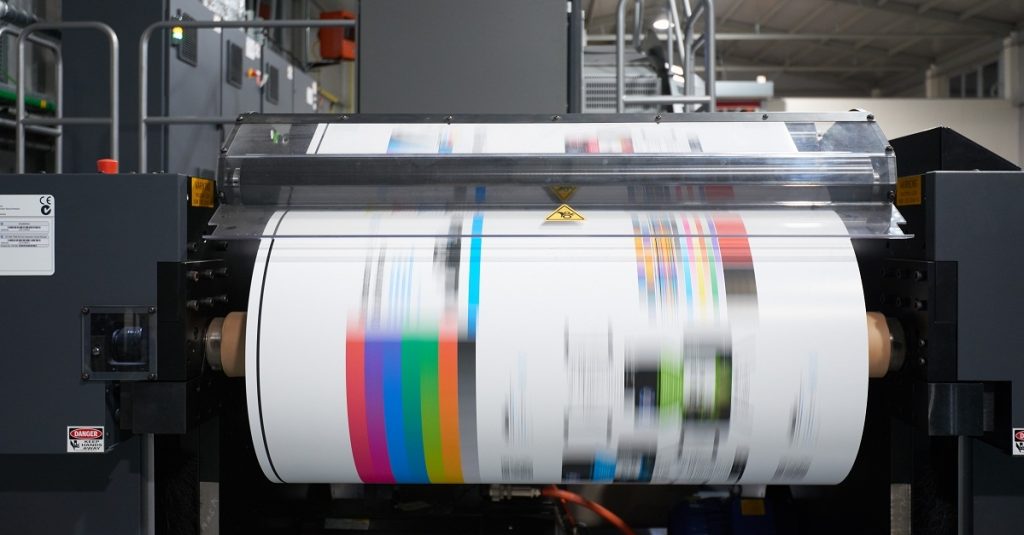
Headlines
News
High-speed inkjet surfaces
April 20, 2017 By Martin Fairbank
 High Definition Nozzle Architecture is HP’s newest print head technology for high-speed inkjet printing, delivering 2,400 nozzles per inch and providing support for dual drop weight per colour.
High Definition Nozzle Architecture is HP’s newest print head technology for high-speed inkjet printing, delivering 2,400 nozzles per inch and providing support for dual drop weight per colour. New surface treatments for paper might enable significant savings in the use of commercial inkjet presses, which remains one of the biggest challenges for wide-spread adoption of what most envision as the future of printing
At PaperWeek Canada, the annual conference of the Canadian pulp and paper industry held in Montreal the week of February 13, 2017, one of the presentations discussed a new surface treatment for paper that could allow high-speed inkjet printers to improve quality and save money on their high quality print jobs.
Inkjet printing is achieved by spraying fine ink droplets on the printing medium from a print head. In order to obtain a good quality image on paper, the ink droplet arriving on the surface of the sheet must be immobilized, to prevent spreading of the ink and blurring of the image. There are two types of inkjet ink: pigment-based and dye-based. Pigment-based inks contain solid coloured particles which remain on the surface of the sheet. Dye-based inks, which are cheaper, absorb into the sheet and often produce duller images.
Commercial high-speed inkjet printing has shown an annual growth rate of about 15 percent over the last five years in the U.S., according to a study by Poyry. Inkjet printing is already the leading digital printing technique on transactional print jobs such as credit card statements where mostly black ink is used, since dye-based inks are cheaper than toners. It is also increasingly used for new business models such as print-on-demand and custom publishing.
Market shift in print
Commercial inkjet printing is starting to take significant market share away from offset printing. There are many reasons for this, including fast setup time, ease of customization, less waste and lower cost per copy for shorter print runs.
High quality marketing communications such as catalogues and brochures are traditionally printed by offset printing on glossy coated paper. With inkjet machines, printing on these types of papers can be a challenge, because the water phase of the ink must pass through the coating while the colorant remains fixed on the surface. For this type of promotional printing, pigment-based inks are the inks of choice for inkjet printers.
To design a paper surface that works well with inkjet inks, there are two strategies. One is to coat the surface with positively charged particles, which immobilizes negatively charged ink pigment particles. An approach using calcium chloride in the coating formulation was developed jointly by HP and International Paper about 10 years ago and is trademarked as ColorLok technology.
The second strategy is to provide a surface treatment that rapidly absorbs the liquid phase while keeping it near the surface of the sheet, and minimizes the drying time required. Home and office inkjet printers print relatively slowly, and the drying time is not critical, but web-based production inkjet printers often need to use inline drying techniques to run paper webs at several hundred feet per minute without ink smearing.
KemPrint 17 in Montreal
An interesting research paper presented in Montreal was given by Bob Hardy from Kemira Paper Chemicals. Kemira has developed a new product, KemPrint 17, that can be applied at the size press of a paper machine. The product is a very high surface area cationic pigment and thus it uses both of the above strategies to immobilize the ink and minimize the set time. Ink penetration into the sheet is significantly reduced, creating high ink densities.
Kemira carried out lab printing trials with their product to demonstrate how it compares with a calcium chloride surface treatment, using either pigment-based or dye-based inks. A constant coat weight of 2.3 g/m² was used. The CaCl2 treatments used a 4:1 mixture of oxidized starch and CaCl2.
Two levels of KemPrint were applied, at 1/3 and 2/3 of the coat weight, mixed with oxidized starch. The results indicate, that for pigment inks, the black print density can be matched with KemPrint and coloured print density can be improved. The colour gamut, where a higher colour gamut value equals more vivid colour reproduction, was also improved with the KemPrint treatments.
The tests were repeated with dye-based inks, and here the KemPrint treatments all gave higher values of print density and colour gamut than the CaCl2 (ColorLok) treatment. This makes sense, as dye-based inks are non-ionic, so the cationic nature of the CaCl2 is ineffective at immobilizing this type of ink.
Print-through tests also showed that the KemPrint product could match or improve the print-through performance of CaCl2, a good indication that liquid penetration into the sheet is being minimized.
High-speed inkjet printers are always looking for the higher print quality for lower cost. This new technology from Kemira, which is now being tried out by a few papermakers and printers, should result in brighter, sharper images, and may allow them in the long run to move from more expensive pigment-based inks to dye-based inks for these high-speed jobs.
Production inkjet is already driving change in the printing industry, both by enabling new applications and by capturing volumes previously produced with analogue technologies such as offset and flexography. Over the past couple of years, there have been major advances in both technology and pricing models, with ink and substrates being front and centre in the future success of the production inkjet model.
Print this page